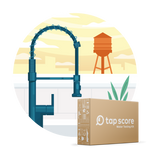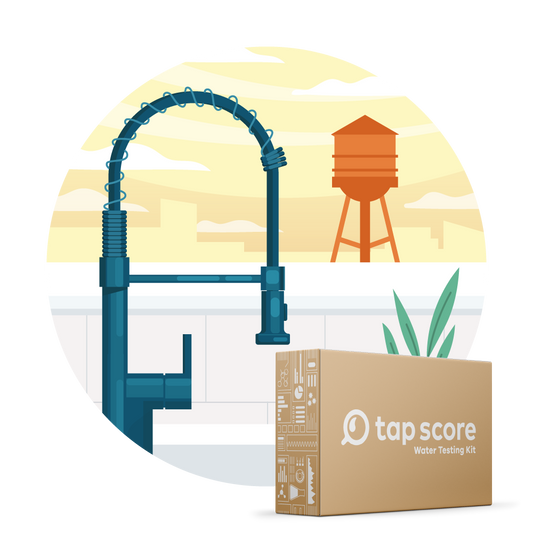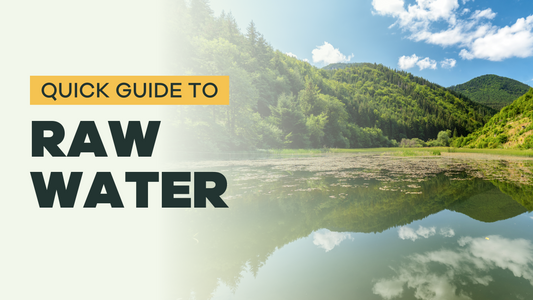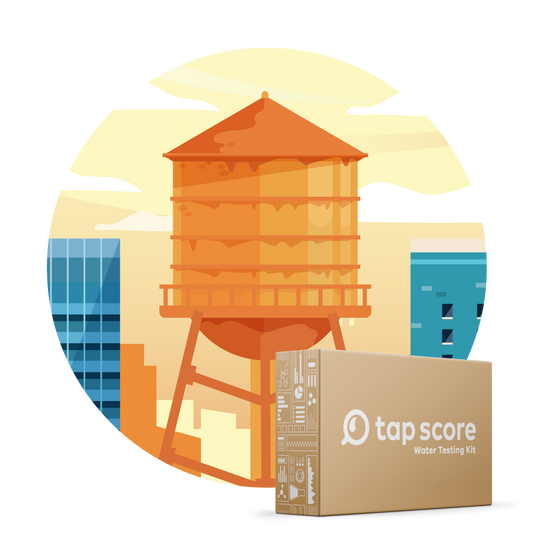
Lead (Pb) in Drinking Water: The Ultimate Guide
Our blog is written by real experts— not AI. Each guide is carefully reviewed and updated based on the latest research. Plus, with no affiliate links, you can count on unbiased insights you can trust.
Lead use dates back thousands of years and can be attributed to every major civilization around the world. In the United States, lead found widespread application in household paint and plumbing materials throughout most of the 20th century. While it has long held a reputation for being highly toxic—particularly to children—attempts to reduce human exposure to lead in developed countries only started in the late 1970s and ‘80s.
In the ultimate guide to lead in drinking water, we explore this notorious heavy metal and its associated risks, sources of contamination and exposure potential, as well as how to test and treat your tap to help keep your household safe from lead.
Table of Contents:
- What Is Lead?
- Lead Contamination of Drinking Water
- Health Impacts of Lead Exposure
- Lead and Regulation
- Recognizing Lead in Drinking Water
- Testing for Lead
- Treating Lead
- What’s the Takeaway?
What Is Lead?
Lead (Pb) is a bluish-silver, naturally occurring metal found in the earth’s crust. It is fairly soft and highly malleable. Most often, lead contaminates drinking water through the corrosion of lead or lead-soldered plumbing. It also contaminates the air and soil and is toxic to humans, animals, and most other lifeforms.
Man-made activities including the former use of leaded gasoline, lead-based paint and plumbing materials in homes are responsible for the bulk of human exposure. Lead and its compounds can be found in paint, ceramics, pipes and plumbing materials, solder, batteries, cosmetics, and ammunition.[1]
While federal and regulatory standards in the United States and many other countries have helped reduce lead levels in occupational settings, consumer products, food, air, soil, and drinking water, lead exposure is still possible because it is still used in a variety of industries and products in countries worldwide.
How Does Lead Contaminate Drinking Water?
Lead contaminates drinking water primarily through the corrosion of leaded plumbing materials like pipes and fixtures. Homes built before 1988 are more likely to feature lead service lines, plumbing fixtures, and solder.
Leaching from Lead Service Lines (LSLs)
Lead service lines (LSLs) are the pipes that connect a property’s plumbing system to the municipal water main that runs underneath the public road. When the lead in these pipes corrodes, lead particles are released into the water that flows directly to your tap. Exactly how much lead leaches into the water depends on:
- Your water’s pH level (lower pH can result in corrosion)
- Water temperature
- Your water’s specific mineral content (low counts can result in corrosion)
- How long the water sits undisturbed in the pipes
- The age and general wear of the pipes
- Whether or not protective scales or layers on pipes exist to prevent corrosion and leaching
Lead service lines were standard until 1986, when Congress amended the 1974 Safe Drinking Water Act to outlaw the use of lead in piping, fixtures, and solder in plumbing intended for human consumption. Many states did not comply until 1988.
Even without lead service lines, some homes include other plumbing materials that have been soldered with lead and can leach harmful particles into your water over time.[2]
Scale, Corrosion, and Plumbing—SimpleLab Tap Score
How Do I Know if I Have a Lead Service Line?
- If you’re on a public water system, you can request information directly from your water utility.
- Because many utilities in the past did not keep detailed records of what materials were used where, you can do some investigating:
- Using a flashlight, a key or coin, and a magnet, you can use the EPA’s helpful lead pipe inspection guide to try to identify a lead pipe, gooseneck, or pigtail
- Looking through tax records, building permits, and real estate listings you can learn: a) the year your house was built, b) the year your house or property first received water service, or c) the year your house was renovated or a new house was built on the property to help you determine whether or not lead-based plumbing materials were ever used or remain.

Note: Private well owners will want to have their water tested by a laboratory, explore option 2, and/or call a professional plumber.
Contamination of Ground and Surface Waters
Although less impactful than corroded piping, lead can leach into ground and surface waters like aquifers, lakes, rivers, and reservoirs. Lead-containing rocks, pollution from heavy industry (including mining and construction), and improper waste disposal in the form of runoff can all contribute to elevated lead levels in ground and surface waters.
What Are the Health Effects of Lead in Drinking Water?
Lead has toxic effects after both acute and chronic exposures and can affect nearly every organ system in the body. Typically, lead levels in drinking water do not reach concentrations that result in acute lead poisoning. But because there is no acceptable level of lead exposure, even small amounts of lead can cause serious health problems over time—especially for pregnant people and small children.
Adult exposure to small concentrations of lead in drinking water over time can result in: [2]
- Increased blood pressure and hypertension
- Decreased kidney function
- Reproductive problems in both men and women
- Joint and muscle pain
- Mild cognitive effects including difficulty concentrating and irritability
Acute lead exposure may result in the following symptoms:
- Memory and concentration issues
- Headaches
- Abdominal pain
- Mood issues, particularly irritability
Lead accumulates in our bodies over time in a process known as bioaccumulation. Lead is stored in the bones and can take decades after exposure has ceased to begin reducing levels.

Who Is Most At Risk?
Children
Lead exposure is exceptionally harmful to a child’s health and development. Even low levels of lead in a child’s blood stream can cause: [3]
- Learning and behavioral problems
- Lower IQ and hyperactivity
- Slowed growth and development
- Hearing and speech problems
- Anemia
Children are highly sensitive to lead exposure. Once lead consumption stops, lead levels in their blood drop gradually; it is also released through sweat and waste. But the physiological and neurological effects of lead in children are considered irreversible.[10]
Addressing lead in schools and child care centers has become one of the Environmental Protection Agency (EPA)’s chief concerns. The Lead & Copper Rule Revisions (LCRR) from 2021 and the new Lead & Copper Rule Improvements (LCRI) prioritize pipe inventories and mandatory sampling practices in schools and child care centers to help reduce childhood exposure to lead.
The Lead & Copper Rule Improvements (LCRI) emphasize making testing results and lead exposure mitigation plans more accessible to the public.
Lead Testing in Child Care Centers: What You Need to Know—SimpleLab Tap Score
Pregnant People
Because lead bioaccumulates and is stored in our bones along with calcium, pregnant females are particularly at risk. During pregnancy, lead is released from the mother’s bones and passed onto the developing fetus. After birth, lead can pass onto the newborn through a mother’s breast milk.[1] This introduces serious risks to the fetus and infant including:
- Increased risk of miscarriage
- Premature birth or low birth weight
- Damage to the baby’s brain, kidneys, and nervous system
- The onset of behavioral issues
What Level of Lead Is Safe in Drinking Water?
Due to the serious health impacts detailed above, there is no safe level of lead in drinking water. Therefore the EPA’s Maximum Contaminant Level Goal (MCLG) for lead is 0. The EPA set this level based on the best available science that reveals how detrimental lead in drinking water is to human health.
Because lead contamination of drinking water is largely a matter of corroded piping linked to a public water system, the EPA released a treatment technique, otherwise known as the Lead and Copper Rule (LCR), rather than a Maximum Contaminant Level (MCL).
The Lead and Copper Rule requires water systems to:
- Control the corrosivity of water through a careful combination of chemicals and water quality parameters
- Establish sampling methods at sites likely to be suffering from lead contamination
- Establish a lead action level—the concentration of lead in a water sample at which utilities are required to take further remedial actions.
Lead Action Level
If more than 10% of tap water samples exceed the lead action level of 15 PPB*, then water systems are required to:
- Take steps to further optimize their corrosion control treatments
- Educate the public about lead in drinking water and the action they can take to further reduce their exposure to lead
- Possibly replace the lead service lines in their jurisdiction
Recent revisions to the Lead and Copper Rule prioritize improvements to locating, inventorying, and replacing LSLs.
*Will be 10 PPB when the LCRI goes into effect, see below.
What Are the Lead and Copper Rule Revisions (LCRR)?—SimpleLab Tap Score
Proposed Lead and Copper Rule Improvements (LCRI)
In order to get even more lead out of our water, the EPA has proposed further improvements to the Lead and Copper Rule Revisions from 2021. The EPA will finalize the Lead and Copper Rule Improvements (LCRI) by October 16, 2024.[11]
Key provisions of the LCRI include:
- Further reducing the lead action level from 15 PPB to 10 PPB
- Requiring public water utilities to regularly update their service line inventories, publish a publicly available LSL replacement plan, and identify the materials of all service lines of “unknown material” once they have delivered their initial LSL inventories
- Strengthening compliance tap sampling through the fifth liter requirement, and necessitating proactive lead reduction actions for utilities with lead level overages (e.g. providing customers with free water filters certified for the removal of lead, making sure customers are informed every step of the remediation effort)
- Requiring the vast majority of public utilities to achieve 100% lead pipe replacement within 10 years

How Do You Know If Lead Is in Your Drinking Water?
Lead cannot be seen, smelled, or tasted in tap water, but the age of your home can be a clue to your risk level. The best way to know if your water is contaminated by lead is by having your water tested through a certified laboratory.
How Common Is Lead Contamination of Drinking Water?
As of January 2024, the EPA estimates that there are currently 9.2 million lead service lines in use across the United States.[12] A National Resource Defense Council (NRDC) survey from 2021 estimated there may be over 12 million LSLs across the country.[7]
High lead levels have been found in tap water in major cities across the U.S. LSLs extend beyond urban centers and have been poorly inventoried in general. Many states and utilities simply do not know how many lead service lines they have or where they are located. However, as previously mentioned, lead service line inventories will have to be updated and improved according to the LCRI.
Resources like water quality reports and Tap Score’s City Water Project can be a useful way to get a better understanding of water quality in your area. However, the CWP and your local water utility’s Consumer Confidence Report (CCR) do not offer water quality details down to a specific tap (which is key when taking your plumbing system into account).
Does Being on Public Water or a Private Well Make a Difference?
Yes and no. Before we dive into the different lead risks private well owners and customers of public water systems face, it’s worth noting that your home’s plumbing is the place to start in order to assess and identify your risk of lead contamination.
Because the use of leaded plumbing materials was the industry standard prior to 1986, homes built as late as 1988 are most likely to contain lead somewhere along the line—regardless of the water supply.
Public Water Systems
Aside from the material of pipes and plumbing fixtures within a home, customers of a public water system face lead risks from their service lines (many—but not all—of these service lines were made from lead). Utilities nationwide are working toward identifying and replacing these lines, but every utility in every state works at a different pace.
Additionally, the way each water utility adjusts its independent treatment and corrosion reduction parameters impacts your risk of lead contamination. Contact your utility for more information. You can also learn if they’ve identified LSLs in your area, what (if any) timeline of action exists for LSL replacement, and some utilities even offer free testing of your home’s water supply upon request—although smaller water systems typically have fewer resources.[4] Once the LCRI goes into effect, utilities will be required to create an action plan to replace all LSLs and make that information available to the public.
Private Well Owners
As a private well owner, you are responsible for the safety of your water. Testing your water annually is highly recommended, both to learn about possible contaminants and to better understand your water’s chemistry, which plays an important role in lead contamination. Groundwater that is corrosive (pH < 6.5) increases your risk of lead leaching.
In addition to piping, well owners should check both the well and the pump for potential sources of lead. Many groundwater wells were constructed with lead-based materials:
- Submersible pumps manufactured prior to 1995 may contain leaded-brass components
- Lead “packers” (a lead packing collar) installed to help seal the well above the well screen were commonly used in wells built prior to 1980, and used occasionally all the way until 1993 [9]
- Driven-point wells may have been shot with lead to clear their screens
- Lead shot or lead wool may also have been installed to keep sand and sediment out of your well
- Lead solder was commonly used to join copper pipes prior to 1986
As a well owner, understanding your environment is key. Groundwater contamination by naturally-occurring heavy metals and minerals depends on your exact geographical location and the depth of your well.
How Can I Reduce or Limit My Lead Exposure?
Before we explore the different ways to treat your water for lead (see below), here are a few ways to limit your exposure if you suspect lead contamination and haven’t yet tested your water or are awaiting results.
- Use only cold water for drinking and cooking. Warm/hot water is more likely to contain elevated levels of lead
- In addition to the above, do not boil water that may be contaminated with lead—boiling will not eliminate lead, instead it will concentrate whatever lead is in the water
- Regularly clean your faucet’s screen (also known as an aerator)
- Regularly flush your cold water system, especially first thing in the morning: Running your cold water tap for a few minutes (1-5) before drinking or cooking helps flush out stagnant, potentially lead-contaminated water and draws from further back in the line
Pipe and fixture replacement is the most proactive plan—especially if you’re a homeowner—but the costs are steep.
If you rent your home and a water test reveals worrying levels of lead contamination, we encourage you to check in with your landlord and/or your local utility about a remediation plan. In the meantime, test and treat your water.
How Do I Test My Water for Lead?
The best way to test your water for lead is through a certified laboratory. While accessing water quality reports or doing your own investigating are helpful options, testing your water with a lab provides the most comprehensive picture of your lead situation.
When Should I Test My Water for Lead?
You should have your water tested for lead if:
- You live in a house or building built prior to 1988.
- You have been told by your utility that your area potentially has lead service lines
- You are a private well owner and have never tested your well water for lead
Advanced City Water Test
Ideal baseline for testing tap water provided by a local water utility–including metals, minerals, and chlorine-related byproducts.
Lead and Copper Water Test
Test two common heavy metal contaminants with laboratory precision.
Sampling Methods
Because lead contamination is largely a plumbing-related issue, you will want to collect your water samples using the First Draw sampling method.
-
The First Draw Method:
Collect the sample after water has been stagnant in pipes for 6+ hours (but not longer than 18 hours)—typically first thing in the morning. Water in this sample will have had time to interact with on-site plumbing and may reveal plumbing-related issues. Collect the sample as soon as it flows from the tap.
-
The Fully-Flushed Method:
Collect the sample at any point in the day after you have flushed the pipes and plumbing—ideally about 5 minutes. This will flush water that has been in direct contact with plumbing for a period of time, and will likely represent any lead potentially coming from the distribution system, rather than your pipes.
Sampling changes according to the upcoming LCRI will require analysis of samples of the first and fifth liters. This Fifth Liter Requirement is a compliance sampling method specific to public water systems and, if applicable, you will be notified by your utility of its requirement.
-
Fifth Liter Samples:
For all water samples from suspected LSLs, collect five (5) one-liter samples consecutively numbered from the kitchen or bathroom faucet as a first draw (typically the faucet where the majority of water is consumed). The water will need to be run continuously and the samples collected continuously. Bottles 1 (liter one) and 5 (liter five) will be analyzed for copper and lead respectively.
LCRR: Improving Lead Sampling Through the 5th Liter Requirement—SimpleLab Tap Score
Can I Use Test Strips for Lead?
DIY test strips are not recommended for contaminants known to have serious health impacts. That’s because they’re not designed to accurately quantify a contaminant’s concentrations in water (strips typically have higher detection limits than analytical instruments, meaning they can't register a contaminant's presence below a certain point). When a contaminant has no safe level, even a small concentration can make a big difference to your water’s safety.
DIY test strips work best for parameters like pH, for chlorine, and for the presence or absence of coliform bacteria. Theoretically, an at-home test strip could reveal whether lead is in your drinking water just by changing color—which should necessitate further action—but it can’t be trusted to accurately represent the severity of the problem or capture low-levels of the contaminant.
Can I Filter Lead from My Drinking Water?
Yes, you can filter lead out of your drinking water. There are several common home water treatment technologies that have proven effective in the removal of lead from drinking water. They include both point-of-use (POU) and point-of-entry (POE) systems and pitcher filters.
Remember to opt for water filters certified by an independent certifying agency like the NSF (National Sanitation Foundation) or WQA (Water Quality Association). You’ll want the packaging or documentation to state the filter is certified to NSF/ANSI Standard 53 or 58 for lead.

If a sample of your water contains lead, you should consider a treatment device. (If you have children in your house, we strongly recommend seeking an alternative water source until you install a treatment device.) Effective treatment technologies for lead include:
- Activated carbon
- Reverse osmosis
- Distillation
Which Treatment Device Is Right For Me?
-
Activated Carbon Technology
Activated carbon technology is designed to trap certain contaminants on their surface while water passes through. Activated carbon technology is used in household pitcher filters, POU faucet or under the sink setups. It’s important to replace your filters regularly for them to work effectively.
- Pitcher filters: Be sure you equip your pitcher with a filter certified by NSF/ANSI standard 53 for the removal of lead. Check for the certification seal on the packaging of any pitcher filter that claims to be effective for the removal of lead. Most base level models do not filter lead.
- POU filters: Filter systems attached to your faucet or right under the sink are also a common and effective way to filter lead from the faucet you use for drinking and cooking. They are cheaper than whole-home POE systems that filter all the water that flows through your home.
-
Reverse Osmosis (RO)
RO systems use pressure to force water through a selective membrane with microscopic pores to allow water molecules through while trapping larger and/or charged molecules like lead compounds.
RO systems are very effective at removing a wide range of contaminants. They are typically whole-home, POE systems and they tend to be expensive, require high amounts of energy, and produce a waste product. For this reason we do not recommend RO unless you have other contaminants you are also trying to treat that require RO. Look for NSF/ANSI standard 58 certification.
-
Distillation
Distillation units boil water, collect the purified vapor, and turn it back into purified water. Contaminants stay in the boiler and the water that results has had all its impurities removed—including beneficial particles like calcium and magnesium.
Distillation removes a wide variety of contaminants and kills pathogens, but energy requirements are high and can get expensive. Distillation units themselves can be expensive and only produce small amounts of water at one time. NOTE: Simply boiling water is not the same as distillation.
The right filtration setup for your household depends on your lead levels and your budget. Typically, for lower levels of lead contamination, investing in a pitcher with a filter certified for the removal of lead will be sufficient—as long as you follow the manufacturer’s recommendations for filter replacement.
NSF/ANSI Certifications Explained—SimpleLab Tap Score
What’s the Takeaway?
Lead is both a serious issue and an all-too-common one, particularly in cities across America.
- Lead contaminates drinking water primarily through the corrosion of lead or lead-soldered plumbing materials (pipes, pumps, fixtures, etc.). Lead service lines (the pipes that transport water from a public water main to a residence) were commonly used prior to 1986.
- There is no safe level of lead in drinking water. Lead negatively affects nearly every organ system in the body and accumulates over time. It is especially harmful to children, who can suffer permanent developmental damage from chronic exposure.
- The age of your home, notices from public utilities, and lab certified water tests can all help you learn about your lead situation. However, lab testing is the only way to get a complete picture of your water quality. This knowledge is useful for understanding what treatment technology will be most useful for removing lead.
Read More
▾Scale, Corrosion, and Plumbing: What You Should Know
Lead Testing In Child Care Centers: What You Need to Know
What Are the Lead and Copper Rule Revisions (LCRR)?
LCRR: Improving Lead Sampling Through the 5th Liter Requirement
Sources and References
▾- Learn about Lead | US EPA
- Basic Information about Lead in Drinking Water | US EPA
- Health Effects of Lead Exposure | CDC
- FAQ: Lead in Drinking Water | Sources of Lead | CDC
- GROUNDWATER INFORMATION SHEET: Lead | CA Waterboards
- Lead and Copper Rule | US EPA
- Lead Pipes Are Widespread and Used in Every State | NRDC
- Protect Your Tap: A Quick Check for Lead | US EPA
- Lead in Well Water Systems - MN Dept. of Health
- Lead Poisoning | WHO
- Proposed Lead and Copper Rule Improvements | US EPA
- EPA: Ground Water and Drinking Water - Lead Service Lines
- How to Find Out If Your Home Has Lead Service Lines | NRDC
- Lead and Copper Rule Revisions (LCRR) Lead Service Lines (LSL) Inventory







